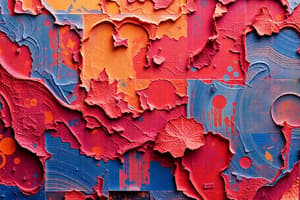Podcast
Questions and Answers
What is the foundation of all drawing according to the text?
What is the foundation of all drawing according to the text?
- Line (correct)
- Shape
- Color
- Form
Which type of line suggests comfort, ease, and change in direction?
Which type of line suggests comfort, ease, and change in direction?
- Horizontal lines
- Jagged/Zigzag lines (correct)
- Vertical lines
- Continuous lines
What do horizontal lines suggest in an artwork?
What do horizontal lines suggest in an artwork?
- Rhythm and movement
- Turmoil and anxiety
- Height and dignity
- Distance and calm (correct)
How can broken lines express in artwork?
How can broken lines express in artwork?
Which visual element is considered the most versatile in art?
Which visual element is considered the most versatile in art?
What is the main difference between thick lines and thin lines in art?
What is the main difference between thick lines and thin lines in art?
What is the key feature of organic shapes?
What is the key feature of organic shapes?
How can tone be used in art?
How can tone be used in art?
What is the main purpose of texture in art?
What is the main purpose of texture in art?
How do squares and rectangles differ in their portrayal compared to circles and ellipses?
How do squares and rectangles differ in their portrayal compared to circles and ellipses?
Which element of art is described as a moving mark by a moving point?
Which element of art is described as a moving mark by a moving point?
What do vertical lines suggest in an artwork?
What do vertical lines suggest in an artwork?
How can jagged/zigzag lines affect the viewer's perception of an artwork?
How can jagged/zigzag lines affect the viewer's perception of an artwork?
What expressive quality is associated with mechanical lines in art?
What expressive quality is associated with mechanical lines in art?
How do freehand lines differ from continuous lines in conveying artistic expression?
How do freehand lines differ from continuous lines in conveying artistic expression?
What type of shape can create a sense of imbalance and tension?
What type of shape can create a sense of imbalance and tension?
Which technique is used to describe the change in angles and curves of shapes depending on the viewpoint?
Which technique is used to describe the change in angles and curves of shapes depending on the viewpoint?
What kind of shapes are precise and look as if they were made with a ruler or other drawing tools?
What kind of shapes are precise and look as if they were made with a ruler or other drawing tools?
How do physical texture and optical texture differ?
How do physical texture and optical texture differ?
Which visual element of art refers to the lightness or darkness of a color?
Which visual element of art refers to the lightness or darkness of a color?
Flashcards are hidden until you start studying
Study Notes
Foundation of Drawing
- Line is the foundation of all drawing
Line Types and Meanings
- Curved lines convey comfort, ease, and a change in direction.
- Horizontal lines suggest calmness, peace, and stability in an artwork.
- Broken lines can express movement, excitement, or even danger.
Visual Element Versatility
- Line is the most versatile visual element in art.
Line Thickness & Meaning
- Thick lines are bold and command attention.
- Thin lines are delicate and emphasize detail.
Organic Shapes
- The defining quality of organic shapes is their irregular and free-flowing nature, mimicking natural forms.
Tone in Art
- Tone is the relative lightness or darkness of a color, used to create depth, contrast, and mood within an artwork.
Purpose of Texture
- Texture adds a tactile quality to an artwork, encouraging viewers to interact with the surface.
Shape Characteristics
- Squares and rectangles often portray order, stability, and formality in art.
- Circles and ellipses are associated with concepts like movement, eternity, and wholeness.
Art Element: Line
- A line can be defined as a moving mark made by a moving point.
Vertical Line Meanings
- Vertical lines in artwork often evoke feelings of strength, power, and authority.
Jagged Line Effect
- Jagged/zigzag lines can create a sense of unease, tension, or even danger within an artwork.
Mechanical Line Expression
- Mechanical lines in art often express a sense of precision, control, and order.
Freehand vs. Continuous Lines
- Freehand lines express spontaneity and individuality.
- Continuous lines convey a sense of flow and movement, typically created without lifting the drawing tool from the surface.
Shape and Tension
- Geometric shapes, especially those with sharp angles, can create a sense of imbalance and tension.
Perspective Technique
- Perspective is a technique used to depict the change in angles and curves of shapes depending on the viewpoint.
Geometric Shape Definition
- Geometric shapes are precise and look as if they were made with a ruler or other drawing tools.
Physical vs. Optical Texture
- Physical texture refers to the actual surface of an artwork and can be felt by touch.
- Optical texture is an illusion of texture created through the use of light, shadow, and color.
Value & Art
- Value is the lightness or darkness of a color, used to create depth, contrast, and mood in art.
Studying That Suits You
Use AI to generate personalized quizzes and flashcards to suit your learning preferences.



